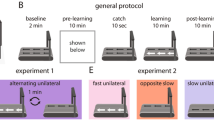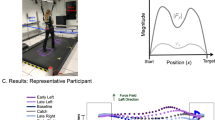Summary.
Gait adaptation is crucial for coping with varying terrain and biological needs. It is also important that any acquired adaptation is expressed only in the appropriate context. Here we review a recent series of experiments which demonstrate inappropriate expression of gait adaptation. We showed that a brief period of walking onto a platform previously experienced as moving results in a large forward sway despite full awareness of the changing context. The adaptation mechanisms involved in this paradigm are extremely fast, just 1-discrete exposures to the moving platform results in a motor after-effect. This after-effect still occurs even if subjects deliberately attempt to suppress it. However it disappears when the location or method of gait is altered, indicating that after-effect expression is context dependent. Conversely, making gait self-initiated increased sway during the after-effect. This after-effect demonstrates a profound dissociation between knowledge and action. The absence of generalisation suggests a simple form of motor learning. However, persistent expression of gait after-effects may be dependent on an intact cerebral cortex. The fact that the after-effect is greater during self-initiated gait, and is contex dependent, would be consistent with the involvement of supraspinal areas.
Similar content being viewed by others
References
FL Bedford (1999) ArticleTitleKeeping perception accurate Trends Cogn Sci 3 4–11 10.1016/S1364-6613(98)01266-2 Occurrence Handle10.1016/S1364-6613(98)01266-2 Occurrence Handle10234221
AM Bronstein (2006) ArticleTitleWhat the vestibulo-spinal system does and what it doesn’t Suppl Clin Neurophysiol 58 120–133 10.1016/S1567-424X(09)70064-9 Occurrence Handle10.1016/S1567-424X(09)70064-9 Occurrence Handle1:STN:280:DC%2BD283hs1Oguw%3D%3D Occurrence Handle16623327
KL Bunday AM Bronstein (2005) ArticleTitleVisuo-vestibular influences involved in the broken escalator phenomenon gait after-effect (GAE) Proc Physiol Soc 1 C7
KL Bunday RF Reynolds D Kaski M Rao S Salman AM Bronstein (2006) ArticleTitleThe effect of trial number on the emergence of the ‘broken escalator’ locomotor after-effect Exp Brain Res 174 270–278 10.1007/s00221-006-0446-2 Occurrence Handle10.1007/s00221-006-0446-2 Occurrence Handle1:STN:280:DC%2BD28risFWgsA%3D%3D Occurrence Handle16639502
DP Carey (2001) ArticleTitleDo action systems resist visual illusions? Trends Cogn Sci 5 109–113 10.1016/S1364-6613(00)01592-8 Occurrence Handle10.1016/S1364-6613(00)01592-8 Occurrence Handle11239810
S Cavaco SW Anderson JS Allen A Castro-Caldas H Damasio (2004) ArticleTitleThe scope of preserved procedural memory in amnesia Brain 127 1853–1867 10.1093/brain/awh208 Occurrence Handle10.1093/brain/awh208 Occurrence Handle15215216
R Cham MS Redfern (2002) ArticleTitleChanges in gait when anticipating slippery floors Gait Posture 15 159–171 10.1016/S0966-6362(01)00150-3 Occurrence Handle10.1016/S0966-6362(01)00150-3 Occurrence Handle11869910
MA Conditt F Gandolfo FA Mussa-Ivaldi (1997) ArticleTitleThe motor system does not learn the dynamics of the arm by rote memorization of past experience J Neurophysiol 78 554–560 Occurrence Handle1:STN:280:DyaK2szosVOqtw%3D%3D Occurrence Handle9242306
P Crenna DM Cuong Y Breniere (2001) ArticleTitleMotor programmes for the termination of gait in humans: organisation and velocity-dependent adaptation J Physiol 537 1059–1072 10.1113/jphysiol.2001.012889 Occurrence Handle10.1113/jphysiol.2001.012889 Occurrence Handle1:CAS:528:DC%2BD38XntVGrtw%3D%3D Occurrence Handle11744777
SE Criscimagna-Hemminger O Donchin MS Gazzaniga R Shadmehr (2003) ArticleTitleLearned dynamics of reaching movements generalize from dominant to nondominant arm J Neurophysiol 89 168–176 10.1152/jn.00622.2002 Occurrence Handle10.1152/jn.00622.2002 Occurrence Handle12522169
F Gandolfo FA Mussa-Ivaldi E Bizzi (1996) ArticleTitleMotor learning by field approximation Proc Natl Acad Sci USA 93 3843–3846 10.1073/pnas.93.9.3843 Occurrence Handle10.1073/pnas.93.9.3843 Occurrence Handle1:CAS:528:DyaK28XivVKrtro%3D Occurrence Handle8632977
SJ Goodbody DM Wolpert (1998) ArticleTitleTemporal and amplitude generalization in motor learning J Neurophysiol 79 1825–1838 Occurrence Handle1:STN:280:DyaK1c3gsV2muw%3D%3D Occurrence Handle9535951
A Karniel FA Mussa-Ivaldi (2003) ArticleTitleSequence, time, or state representation: how does the motor control system adapt to variable environments? Biol Cybern 89 10–21 Occurrence Handle12836029
G Knoblich N Sebanz (2005) ArticleTitleAgency in the face of error Trends Cogn Sci 9 259–261 10.1016/j.tics.2005.04.006 Occurrence Handle10.1016/j.tics.2005.04.006 Occurrence Handle15925800
DA McVea KG Pearson (2006) ArticleTitleLong-lasting, context-dependent modification of stepping in the cat following repeated stumbling-corrective responses J Neurophysiol 97 659–669 10.1152/jn.00921.2006 Occurrence Handle10.1152/jn.00921.2006 Occurrence Handle17108090
SM Morton AJ Bastian (2006) ArticleTitleCerebellar contributions to locomotor adaptations during splitbelt treadmill walking J Neurosci 26 9107–9116 10.1523/JNEUROSCI.2622-06.2006 Occurrence Handle10.1523/JNEUROSCI.2622-06.2006 Occurrence Handle1:CAS:528:DC%2BD28XpvFWqtLw%3D Occurrence Handle16957067
R Osu S Hirai T Yoshioka M Kawato (2004) ArticleTitleRandom presentation enables subjects to adapt to two opposing forces on the hand Nat Neurosci 7 111–112 10.1038/nn1184 Occurrence Handle10.1038/nn1184 Occurrence Handle1:CAS:528:DC%2BD2cXmvVGltA%3D%3D Occurrence Handle14745452
T Poggio E Bizzi (2004) ArticleTitleGeneralization in vision and motor control Nature 431 768–774 10.1038/nature03014 Occurrence Handle10.1038/nature03014 Occurrence Handle1:CAS:528:DC%2BD2cXotl2kt7g%3D Occurrence Handle15483597
RF Reynolds AM Bronstein (2003) ArticleTitleThe broken escalator phenomenon. After-effect of walking onto a moving platform Exp Brain Res 151 301–308 10.1007/s00221-003-1444-2 Occurrence Handle10.1007/s00221-003-1444-2 Occurrence Handle1:STN:280:DC%2BD3szltVyjtA%3D%3D Occurrence Handle12802549
RF Reynolds AM Bronstein (2004) ArticleTitleThe moving platform after-effect: limited generalization of a locomotor adaptation J Neurophysiol 91 92–100 10.1152/jn.00495.2003 Occurrence Handle10.1152/jn.00495.2003 Occurrence Handle1:STN:280:DC%2BD2c%2FhvV2nsg%3D%3D Occurrence Handle12944537
RF Reynolds AM Bronstein (2006) ArticleTitleSelf-initiated gait increases susceptibility to the moving platform after-effect Neuroreport 17 1503–1505 10.1097/01.wnr.0000234741.04700.3e Occurrence Handle10.1097/01.wnr.0000234741.04700.3e Occurrence Handle16957597
A Sato A Yasuda (2005) ArticleTitleIllusion of sense of self-agency: discrepancy between the predicted and actual sensory consequences of actions modulates the sense of self-agency, but not the sense of self-ownership Cognition 94 241–255 10.1016/j.cognition.2004.04.003 Occurrence Handle10.1016/j.cognition.2004.04.003 Occurrence Handle15617673
RA Scheidt JB Dingwell FA Mussa-Ivaldi (2001) ArticleTitleLearning to move amid uncertainty J Neurophysiol 86 971–985 Occurrence Handle1:STN:280:DC%2BD3MvltVemsQ%3D%3D Occurrence Handle11495965
R Shadmehr (2004) ArticleTitleGeneralization as a behavioral window to the neural mechanisms of learning internal models Hum Mov Sci 23 543–568 10.1016/j.humov.2004.04.003 Occurrence Handle10.1016/j.humov.2004.04.003 Occurrence Handle15589621
R Shadmehr ZM Moussavi (2000) ArticleTitleSpatial generalization from learning dynamics of reaching movements J Neurosci 20 7807–7815 Occurrence Handle1:CAS:528:DC%2BD3cXns1eitrc%3D Occurrence Handle11027245
KA Thoroughman JA Taylor (2005) ArticleTitleRapid reshaping of human motor generalization J Neurosci 25 8948–8953 10.1523/JNEUROSCI.1771-05.2005 Occurrence Handle10.1523/JNEUROSCI.1771-05.2005 Occurrence Handle1:CAS:528:DC%2BD2MXhtVOqs7vI Occurrence Handle16192385
Wimalaratna MR, Nadarajah L, Bunday KL, Bronstein AM (2007) Testing the broken escalator phenomenon on patients with midline cerebellar lesions. Abstracts of the Association of British Neurologists spring meeting. J Neurol Neurosurg Psychiatry (in press)
Author information
Authors and Affiliations
Rights and permissions
About this article
Cite this article
Reynolds, R., Bronstein, A. The moving platform after-effect reveals dissociation between what we know and how we walk. J Neural Transm 114, 1297–1303 (2007). https://doi.org/10.1007/s00702-007-0791-8
Received:
Accepted:
Published:
Issue Date:
DOI: https://doi.org/10.1007/s00702-007-0791-8




